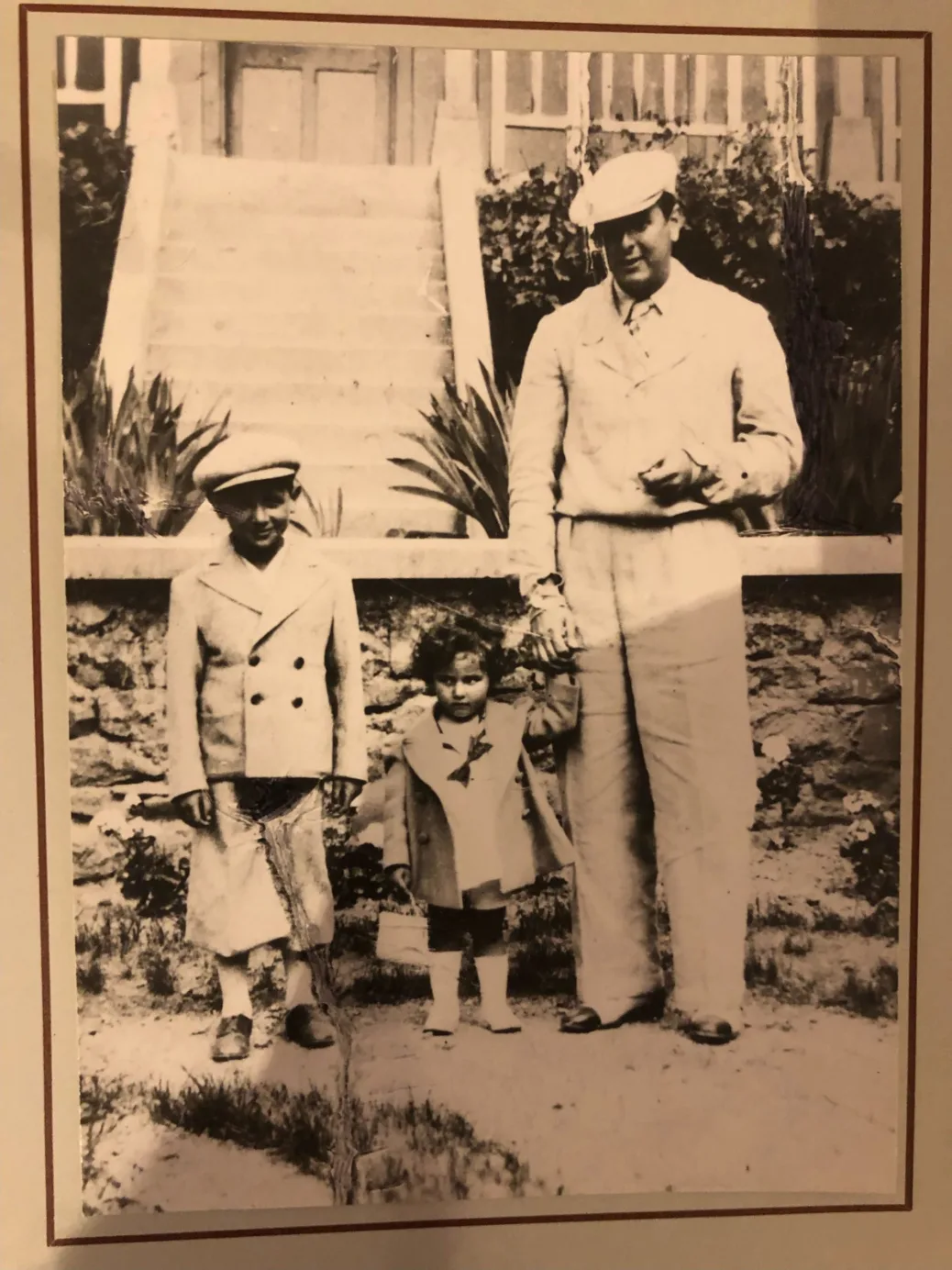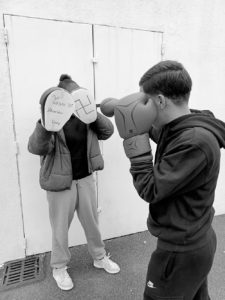Adolphe FEINSTEIN
Adolphe Feinstein with his niece and nephew, Suzanne and Marcel Coifman, taken in 1939-1940. Annie Esterzon’s personal collection.
Who was Adolphe Feinstein?
A group of 9th grade students from the Jean de la Fontaine middle school in Le Mée-sur-Seine worked on the biography of Adolphe Feinstein, who was deported to at the age of 39 to Auschwitz, where he died.
As part of their research, the students visited the Shoah Memorial in Paris, where they listened to the testimony of Anna Koch, who was hidden as a child during the war. They then visited the Drancy memorial.
Thanks to Adolphe’s niece, Annie Esterzon, we have a photograph of Adolphe. We have been in regular contact with Ms. Esterzon, who kindly provided us with the information we needed to build the family tree. We would like to thank her for her kindness and her time.
The students came up with an imaginary vision of Adolphe: a boxer who fought back, with reference to Nazism. After all, Adolphe was a Resistance fighter.
Two of the students also wrote an imaginary monologue, based on Adolphe’s experiences in Drancy.
I. Before the war
1) His family

Adolphe’s family tree, drawn by two 9th grade students
Adolphe Feinstein had black hair, brown eyes, a regular forehead, a small nose and an oval face. He was 5’4” tall.
a) His brothers and sisters
Adolphe’s parents were Abraham Feinstein and Sarah Eidelman. He was far from an only child: in fact he had 8 siblings. The eldest was Clara, who was born on November 10, 1897, then Marcelle, born on February 10, 1900, Anna, on August 5, 1901, Joseph on September 19, 1903 and Adolphe himself on September 5, 1905. After him came Samuel, born on September 19, 1909, Paul, on September 3, 1912, Michel on January 30, 1915 and finally Gabrielle, on April 12, 1917.
- b) His parents
Abraham Feinstein was born on April 16, 1905 in Galatz, Russia. Adolphe’s paternal grandparents were Wolf Feinstein and Naissa Levy.
Sarah Eidelman, Adolphe’s mother, was born on August 10, 1874 in Akermann, Russia. She was the daughter of Joseph Eidelman and Gabrielle Abramovitch.
Adolphe’s father Abraham was a soldier in the infantry at Balta, near Odessa, in 1913. Then, during the First World War he went twice to Les Invalides in Paris to try to enlist, the second time on August 27, 1914, but was turned down as a result of a medical examination on September 14 of the same year. Abraham had a brother, Simon, who lived on rue du Figuier in Paris, and a sister, Adèle, who lived in Chicago.
Abraham and his family had been living in France since 1900. Abraham was employed by the Spalter company, which manufactured caps, hats and berets, as of December 13, 1908. On December 9, 1924, the Police Headquarters approved Abraham’s application for French nationality. On January 26, 1925, Abraham Feinstein was naturalized as a French citizen.
Clara and Marcelle also applied for French citizenship.
According to Abraham’s citizenship application, his son Joseph had been caught shoplifting in 1918 at the age of 14. Adolphe had also stolen five items from the market at City Hall in 1921, at the age of 15.
2) Where he lived
The Feinstein family moved house quite frequently. They lived in rue des Jardins Saint-Paul, rue Charles V, where Adolphe was born, rue de la Cerisaie, rue François Miron, rue de la Verrerie, place de la Bastille, rue de la forge Royale from April 27, 1914 to 1919, and then at 19 rue Beccaria, in the 12th district. Adolphe’s widow lived in this last apartment until 1970. In the 1946 census, Cornelia declared that Adolphe was still living at home, probably because at that point she did not know what had happened to him.
a) His time at 19 rue Beccaria
Adolphe Feinstein lived at 19 rue Becaria in the 12th district of Paris, with his parents Abraham and Sarah, and his siblings Clara, Marcelle, Anna, Joseph, Samuel, Paul, Michel and Gabrielle. Marcelle was a cap-finisher, Anna a milliner, Samuel an upholsterer’s apprentice and Paul an electrician. There was another family by the name of Fayt in the same building, who were clerks and janitors, while the father of the Lavoux family was a locksmith, and a Mr. Loyot was a carpenter. The Feinsteins’ neighbors were all from working-class families. Many came from outside the Paris area. The Feinsteins were the only family from Russia. There were a few Italian families and one Polish family, the Jouraffs, who were deported on Convoy 47.
b) His time at 247 boulevard Voltaire
In 1931, Adolphe moved to 247 boulevard Voltaire in the Sainte Marguerite district of Paris with Albert and Cornélia, his son and daughter-in-law. The Feinsteins’ neighbors were much more cosmopolitan than those on rue Beccaria: they came from Spain, Armenia, Turkey, Italy and Poland. Lazare Weigler, a tailor who lived at 247 boulevard Voltaire at the same time as the Feinsteins, was deported on Convoy 9.
3) His military service
In 1925, when Adolphe turned twenty, he was called up for military service. Almost from the outset, he was discharged due to health problems. Initially, he was assigned to the “auxiliary service”. This was for men in poor health who were unable to undertake active service in the army, but who were still obliged to do national service. He was diagnosed with chronic otitis media in his right ear and a varicose vein in his right leg. He was drafted into the 21st Colonial Infantry Regiment. After missing a number of roll calls, he returned voluntarily to the corps on September 4, 1926 and was disciplined. He was then sent back to his quarters with a good behavior certificate.
On May 22, 1926, Sarah, Adolphe’s mother, died.
In 1929, he was called up to the Colonial Infantry center no. 49, but was not assigned to a unit.
In September 1939, when the war broke out, he was recalled to active service. What happened to him after that is unclear.
4) His marriages
a) Lucie Bastiens
Adolphe Feinstein married Lucie Bastiens on March 26, 1927 in the 4th district of Paris. He was 22 and she was 17. She was a day worker and lived on rue des Immeubles Industriels with her maternal grandmother, Constance Henriette Lecoq, as her parents, Henri Alphonse Bastiaens and Julie Vallot, were both dead. Lucie was born in Ambert in the Puy de Dôme department of France. The witnesses at the wedding were Léon Zeligfeld, a hatmaker, and Maurice Vablot, a planer. Only Adolphe’s father, Abraham, was at the wedding. According to his voter registration card, Adolphe worked as a colorist or varnisher.
On January 9, 1929, Adolphe and Lucie got divorced.
b) Cornelia Spanjerberg
Adolphe got remarried, to Cornélia Spanjerberg on March 26,1932. She was born in Antwerp, Belgium, on October 16, 1904. Her father, Jan Spanjerberg, and mother, Jacoba Ripet, did not go to the wedding. There were two witnesses at the ceremony: Berthe Nuytkens and Yvonne Zimmerman, both of whom worked in a cardboard factory, as did Cornelia.
Adolphe and Cornelia had a son, Albert, who was born on February 17, 1929 in Paris. Adolphe officially acknowledged that he was the father of the by on August 20 of the same year.
On February 11, 1929, Abraham, Adolphe’s father, died.
II. The war
1) The Resistance
Cornélia, Adolphe’s widow, tirelessly tried to have her husband recognized as having been a member of the Resistance. In the 1960s, she made a number of applications for him to be granted the status of deported resistance fighter. This led to a series of investigations, which helped us to put together Adolphe’s life story.
In September 1940, Adolphe joined the Communist Party. He was contacted by a Resistance member by the name of Paysé (known as Séverin, Bertrand or Dudal). Adolphe regularly took part in anti-Nazi propaganda campaigns, distributing leaflets and putting up posters. On June 1, 1941, he joined the National Front, an offshoot of the Communist Party and became a liaison officer. He was a sergeant and his pseudonym was Négus. We also discovered that he was a member of a Francs-tireurs et partisans français protection unit.
René Derrien, who had been a schoolteacher in Bois-le-Roi since 1941 and was also the town hall secretary, was questioned as part of an investigation carried out by the Prefect of the Eure department in 1963. He stated that he knew of no one by the name of Adolphe Feinstein who had lived in the town, and that he had no knowledge of any arrests having been made by the German police. We contacted the staff at the Bois-le-Roi town hall, but they had no information about Adolphe Feinstein either.
However, the records show that on May 15, 1944, the German police arrested Adolphe in Bois-le-Roi and took him to Fresnes prison, south of Paris. On July 19, 1944, he was transferred to Drancy camp.
In 1970, Adolphe Feinstein’s status as a deported resistance fighter was revoked. His file reads: “It has not been confirmed that his detention was the result of a defined act of resistance against the enemy”.
According to his niece, who we have been in contact with, Adolphe spent some time in Nice during the war, but we have no way of proving this.
2) Arrest and deportation
Adolphe Feinstein was arrested on May 15, 1944 and interned at Fresnes and then Drancy.
Adolphe arrived at Drancy together with Ernest Mandelbaum, another prisoner from Fresnes. They were placed on the 4th floor on stairwell 18, after which Adolphe was moved to the 2nd floor on stairwell 2. He was held in Drancy for twelve days in all.
Clara, Adolphe’s sister was in Drancy at the same time, together with her husband, Salomon Scher, and her two children, Gaston, who was 11 and Serge, who was 16. They were all deported on the same convoy. Might Adolphe have met up with them there? Might they have stayed together in Drancy?
An imaginary monologue, spoken by Adolphe, written by two students:
“I was arrested by the German police at Bois-Le-Roi and interned in Fresnes jail due to my work with the Resistance. As I’m Jewish, I and some of my fellow prisoners from Fresnes were sent to Drancy. Why were we going there? What were they going to do with us? When we here, it was very hot. The whole place is surrounded by barbed wire. A building site turned into a detention camp, that’s what Drancy is. Our living conditions are terrible, the beds are uncomfortable, the walls are concrete, the floors are concrete, there’s no privacy and we’re bullied by countless people. The children are crying and the adults are depressed. Where are we, and why are we here? I’ve had to change stairwells several times since I arrived in this horrible place. OK, the room doors are open, but we’re locked in as if it’s some sort of prison.
As I was coming down the stairs just now I saw my sister, her children and then her husband. I thought I was dreaming. I ran to hug them with all my might. I thought I’d never see them again, and now I’m so overcome with emotion at seeing them that I can hardly speak.”
Convoy 77 left Drancy for Auschwitz on July 31, 1944. Adolphe was 39 years old.
III. After the war
The Feinstein family suffered heavily during the Holocaust: Clara (married name Scher) and her family, Anna (married name Coifman) and her family and Gabrielle Feinstein were all arrested and deported. Anna and Gabrielle were deported on Convoy 76, while Clara and her family were deported on Convoy 77.
Gabrielle Feinstein was the only one of the family to survive the camps. She only weighed about 64 pounds when she returned to France. Her daughter, Annie Esterzon, who was born a year later, is now 77 years old. She has 3 children and 6 grandchildren. Her brother has two children and a grandson. She wrote this to us: “It’s life’s revenge on death: “They wanted to bury us; they didn’t understand that we were seeds.”


 Français
Français Polski
Polski










